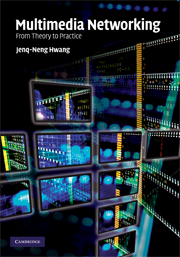Book contents
- Frontmatter
- Contents
- Preface
- Acknowledgements
- List of abbreviations
- 1 Introduction to multimedia networking
- 2 Digital speech coding
- 3 Digital audio coding
- 4 Digital image coding
- 5 Digital video coding
- 6 Digital multimedia broadcasting
- 7 Multimedia quality of service of IP networks
- 8 Quality of service issues in streaming architectures
- 9 Wireless broadband and quality of service
- 10 Multimedia over wireless broadband
- 11 Digital rights management of multimedia
- 12 Implementations of multimedia networking
- Index
9 - Wireless broadband and quality of service
Published online by Cambridge University Press: 26 January 2010
- Frontmatter
- Contents
- Preface
- Acknowledgements
- List of abbreviations
- 1 Introduction to multimedia networking
- 2 Digital speech coding
- 3 Digital audio coding
- 4 Digital image coding
- 5 Digital video coding
- 6 Digital multimedia broadcasting
- 7 Multimedia quality of service of IP networks
- 8 Quality of service issues in streaming architectures
- 9 Wireless broadband and quality of service
- 10 Multimedia over wireless broadband
- 11 Digital rights management of multimedia
- 12 Implementations of multimedia networking
- Index
Summary
With the gradual paradigm shift from analog to digital media, from push-based media broadcasting to pull-based media streaming, and from wired interconnectivity to wireless interconnectivity, wireless broadband access with provisioned quality of service (QoS) for digital multimedia applications to mobile end users over wide area networks is the new frontier of the telecommunications industry. The shift from wired to wireless Internet is also coming as a strong wave. The great success of broadband wireline services (either based on cable or DSL interconnectivity) and short-range portable wireless data services (based on Wi-Fi) has created a strong consumer demand for wireless broadband Internet anytime and anywhere. Wireless technology describes telecommunications in which electromagnetic waves carry the signal over part of or the entire communication path without cables. Wireless broadband is an extension of point-to-point wireless communication for the delivery of highspeed and high-capacity pipe that can be used for voice, multimedia, and Internet access services. Though there are many technologies available for providing broadband wireless access to the Internet, the main focus is on 3G, Wi-Fi, and WiMAX owing to their potential benefits (see Figure 9.1). The wireless LAN (WLAN or the so-called Wi-Fi standards [1]) technologies IEEE 802.11a/b/g and the next generation very-high-data-rate (>200Mbps) IEEE 802.11n are being deployed everywhere for Internet access (the so-called hotspot) with very affordable installation costs. Almost all newly shipped computer products and more and more consumer electronics also come with WLAN receivers for Internet access. To provide mobility support for Internet access, cellular-based technologies such as 3G networking [2] [3] are being deployed aggressively with more and more multimedia application services from the traditional telecommunication carriers.
- Type
- Chapter
- Information
- Multimedia NetworkingFrom Theory to Practice, pp. 301 - 364Publisher: Cambridge University PressPrint publication year: 2009

